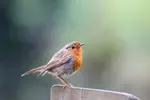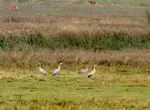- Home
- Wildlife in the UK
- Mute Swans
Mute Swans on Your Local Walks: Watch, Enjoy, Respect
My fascination with Mute Swans started when I was a child, feeding the ducks at a local pond.
There’s something completely captivating about them, isn’t there?
One minute they’re gliding by with the sort of effortless grace I can only dream of, and the next they’re hissing at a territorial goose with a ferocity that makes you take a sharp step back.
They’re such a classic part of a walk by the water, but they are often misunderstood. We’ve all heard the stories, and perhaps even seen a bit of that famous aggression first-hand.
So, I wanted to pull together a proper look at these beautiful, complicated birds. We’ll untangle some of the myths and discover a few surprising facts about how they live.
And for those of us with a camera, I’ll share what I’ve learned about how to take photos that do justice to those brilliant white feathers without turning them into a blurry, bright blob.
Come on then, let’s get to know the Mute Swan a little better.
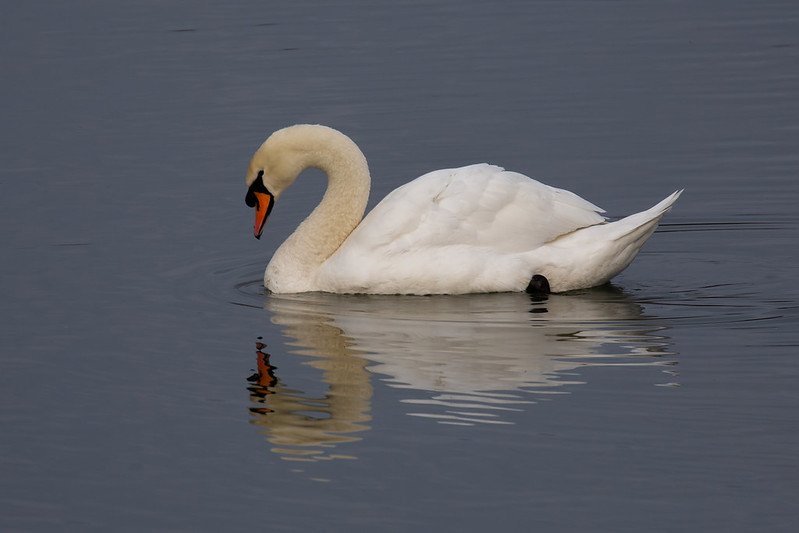 The iconic elegance of a Mute Swan perfectly reflected on calm water.
The iconic elegance of a Mute Swan perfectly reflected on calm water.Understanding Mute Swan Behaviour
Of all the things that might send you scarpering on a walk through the English countryside, a swan probably isn’t high on your list. An angry farmer, maybe. A sudden downpour, almost certainly. But a bird that’s usually the very picture of serenity?
Beats me. But it happens.
My husband and I had just such an encounter at Summer Leys Nature Reserve.
We were ambling along, heading for one of the hides, when we met him. A magnificent Mute Swan, who had parked himself squarely in the middle of the path with an expression that said, quite clearly, that he was having none of it. None of us, our walk, or our silly plan to visit his hide.
I couldn't help but admire the sheer audacity of it; the brilliant white form, the elegantly aggressive curve of the neck. It was a masterclass in minimalist intimidation.
We, being sensible people who’ve grown rather attached to our limbs, decided against a debate. We backed away. Slowly.
And this is the thing with swans. While they’re unlikely to cause you grievous bodily harm—that old tale about them being able to break your arm is, thankfully, nonsense—an encounter can still be rather... nerve wracking.
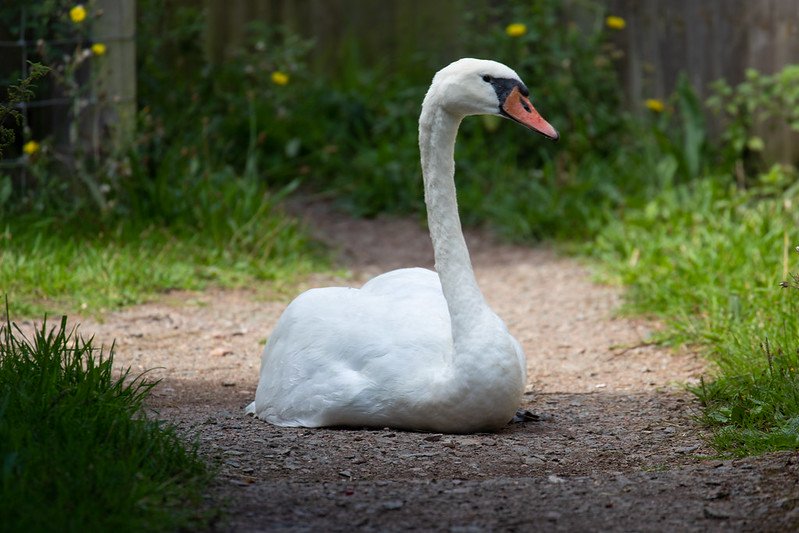 An unscheduled stop. This chap at Summer Leys had very firm ideas about right-of-way, so we decided a detour was in order.
An unscheduled stop. This chap at Summer Leys had very firm ideas about right-of-way, so we decided a detour was in order.They are fiercely protective, you see. The male, or cob, takes his role as guardian of the family very seriously indeed, and he won’t think twice about hissing and charging with his wings half-raised if he thinks you’re a threat.
My advice? Don’t get into a staring contest, it’s terribly impolite. Give them their space. Plenty of it.
Because while getting on the wrong side of one is unlikely to land you in hospital, you could find yourself in a spot of legal bother under the Wildlife and Countryside Act if the bird comes off worse.
Honestly, it's best for everyone to just admire their beauty from a respectable distance. Let them get on with their day, and you can get on with yours. Preferably without having to re-route your entire walk.
Take a closer look at the raw intensity of nature with our page on a battle between male mute swans.
How can you recognize a mute swan?
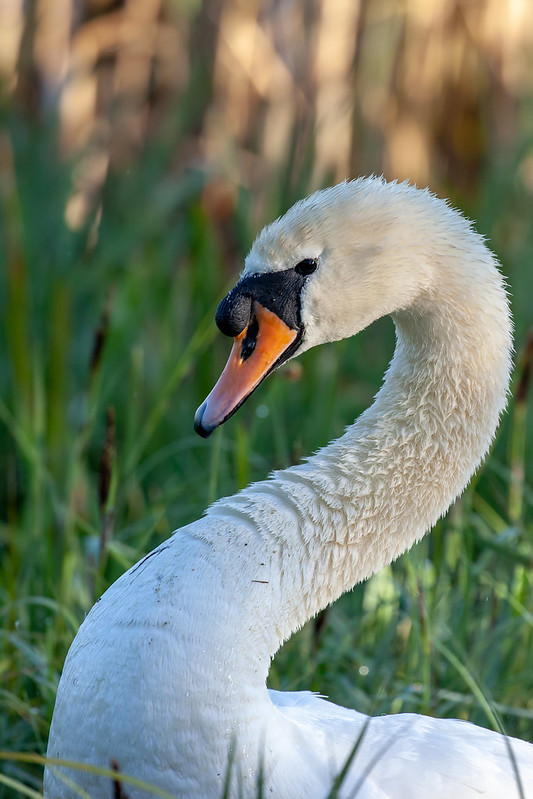 The orange beak and curved neck of an adult mute swan
The orange beak and curved neck of an adult mute swanLuckily for us, the Mute Swan is one of the easier spots in the British countryside. You don’t need to be an expert to tick this one off your list.
For a start, they are magnificently big and brilliantly white, so they’re pretty hard to miss.
But if you want to be certain, the key is to look at the beak. It's a bright, almost startling orange, with a black tip. The males (cobs) have a distinctive black knob right at the base where it meets the face.
That, along with their famously graceful, curved neck, is what really sets them apart from the other swan species you might see here in the winter.
Are mute swans really mute?
It’s one of those names that makes you wonder, isn't it? The ‘Mute’ Swan.
I can assure you, from personal experience, they are definitely not mute. Not when they’re defending a nest, anyway. You’ll get a hiss that’s sharp enough to make you jump out of your skin. And you’ll hear their little ones, the cygnets, making soft peeping sounds to keep track of their mum.
But the sound that truly defines them, the one that makes you stop and scan the sky, isn’t a voice at all. It’s the sound of their wings.
It’s an incredible, rhythmic whoomp-whoomp-whoomp that you almost feel as much as you hear. These are huge birds, and getting all that weight into the air takes a monumental effort. You can sometimes see them running across the water, wings beating hard, to get enough lift.
That throbbing sound of their flight is unmistakable. It’s nothing like the loud, trumpeting calls of the Whooper Swans that fly over in winter. This is a sound that’s quieter, more powerful.
The breeding season
For me, one of the surest signs that spring has truly arrived is when the Mute Swans start getting serious.
It’s a proper commitment. They often pair for life, but it’s fascinating to watch them reaffirm that bond as they begin building their nest.
You’ll see them working together to create this huge mound of reeds and plants, often in the same spot they used the year before. He’ll do the heavy lifting, bringing the materials, but she’s the architect, meticulously arranging everything just so.
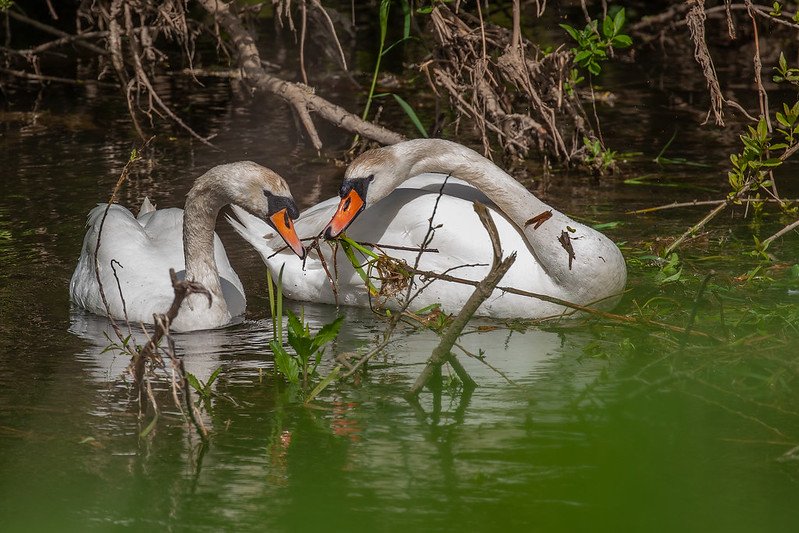 Courting behaviour on the river at Thrapston, Northamptonshire
Courting behaviour on the river at Thrapston, NorthamptonshireAnd while she’s sitting on the eggs, the cob is never far away. He is the most diligent, formidable guard you can imagine. Honestly, this is when their protective instincts are off the charts, and you have to respect that.
The law protects them from being disturbed, but really, it’s just common sense. The only way to watch them is from a good distance, with a long lens and a bit of patience. It’s their moment, after all, not ours.
But the reward for that patience is pure magic.
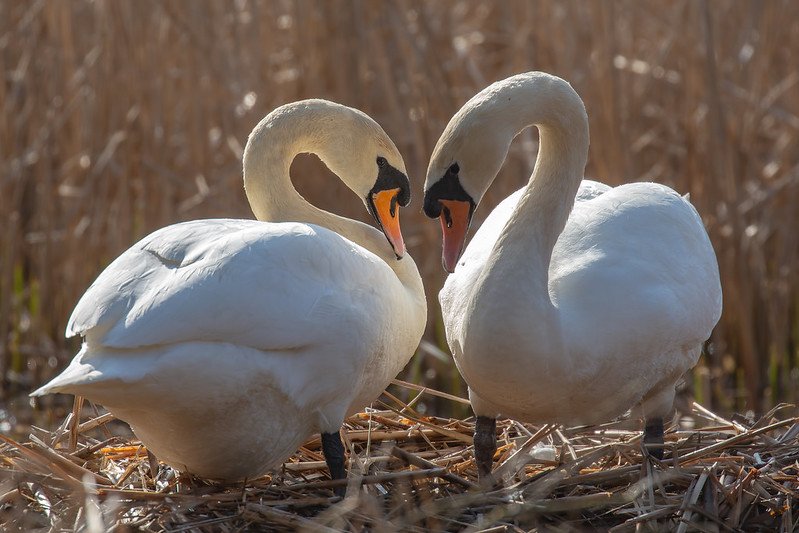 Building the nest at the edge of the lake
Building the nest at the edge of the lakeOne day, the nest is suddenly full of tiny, peeping balls of grey fluff.
It’s wonderful to watch them over the next few months as they go through that awkward, scruffy 'ugly duckling' phase, before finally emerging, about a year later, in their brilliant white adult feathers. Their beaks even change colour, from a dark grey to that signature orange.
Following a single family through all these changes is one of the most rewarding projects you can have as a photographer. A real story, unfolding right in front of you.
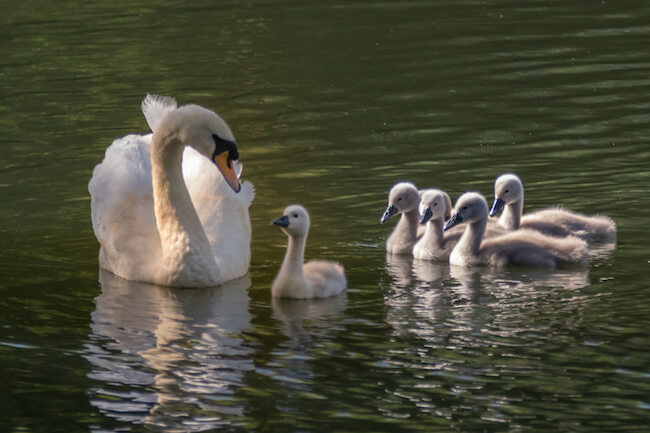 An attentive Mute Swan parent guiding five young cygnets across the water.
An attentive Mute Swan parent guiding five young cygnets across the water.The parents are completely devoted, patiently teaching the cygnets all they need to know. You’ll see them stirring up the sediment with their feet or pulling up weeds to show the little ones what’s good to eat.
But the sight that gets me every single time, the one that’s guaranteed to make me smile, is a tiny cygnet hitching a ride on a parent’s back, all bundled up and safe in those deep feathers. It’s just wonderful.
This cosy family unit sticks together for a good four or five months. But as winter approaches, you might witness what looks like a rather dramatic family fallout. The parents will suddenly start chasing their now quite large youngsters away.
It can look awfully harsh. But it’s a necessary, if tough, lesson in independence. A not-so-gentle nudge to go and find their own way in the world before the next breeding season begins all over again.
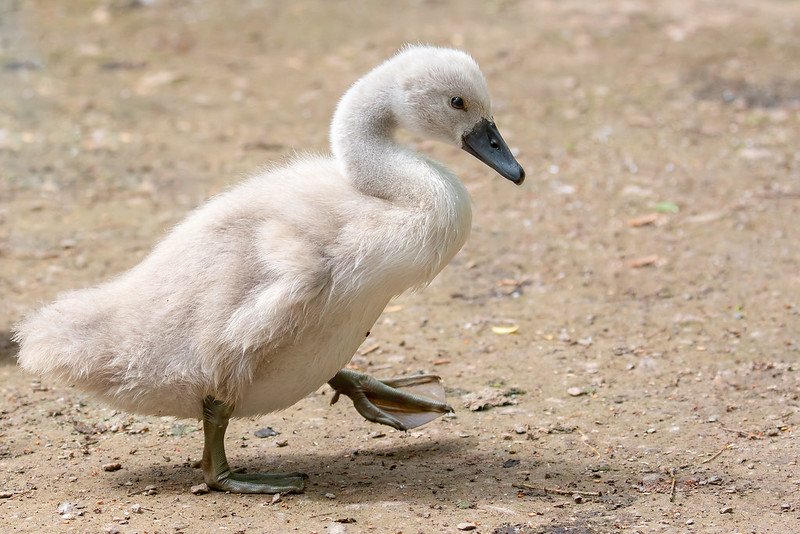 A cygnet crossing the path in front of me
A cygnet crossing the path in front of meLifespan and Threats
You would think a bird so large and majestic would live to a grand old age, and some certainly do. While a typical lifespan is around ten years, ringed birds have been known to live for much, much longer—I’ve read reports of one reaching 28!
But getting to that age isn’t easy. It’s a sad truth that while a fox might be a natural worry, the greatest dangers our swans face today come from our world, not theirs.
It’s the things we leave behind, mostly. Discarded fishing line is a terrible hazard, causing awful injuries. Thankfully, lead poisoning from fishing weights has become much rarer since the ban in the 80s, which is some good news at least.
But they still face dangers from power lines along their flight paths and, something I’d never have considered, can mistake a wet road for a river on a gloomy day, with heartbreaking results.
And then there's the deliberate cruelty, which is something I just can't get my head around. It's a sad reality that these beautiful birds are still targeted, even though it's a punishable crime.
Habitat and Distribution
One of the great things about Mute Swans is that you don’t have to venture into the wild unknown to find them.
They’re a familiar sight all over the UK, happy to make a home on almost any slow-moving river, canal, or village pond. You’ll even spot them waddling about in nearby fields, looking slightly out of place as they graze on the grass.
And while they are famously territorial when they’re raising a family—and believe me, they won’t let you forget it—their whole personality can change later in the year.
The main reason for this is the annual moult. For about six weeks in late summer, they lose all their flight feathers at once, leaving them completely grounded. I can’t imagine how vulnerable that must feel.
You’ll often find them gathering in large, sociable flocks during this time, and through the winter too, when food is harder to come by. There are some places, like the swannery at Abbotsbury oin Dorset, or the Welney Wildlife and Wetlands Trust in Norfolk, where hundreds gather. The sight and sound of a flock that big must be absolutely breathtaking.
Diet and Feeding Considerations
You only have to watch a swan for a few minutes to realise they are magnificent, non-stop eating machines. An adult can get through several kilos of vegetation a day, which is quite an appetite!
Their main menu consists of all the plants you find under the water.
They use those incredible long necks to reach right down for pondweed, algae, and roots. Often you’ll see them tilt right over, tail feathers straight up in the air, to get to the tasty stuff deeper down. It’s a technique called ‘upending’, and it’s something you’ll often see ducks doing, too.
But they’re not fussy. They’re just as happy to wander onto a riverbank for a good graze on the grass, looking for all the world like fluffy white sheep. And while they’re nibbling away, they’ll also accidentally swallow small insects, snails, and even tiny fish.
Of course, the big question is always about feeding them. To bread, or not to bread?
We’ve all done it, haven’t we? Tossing bits of a leftover sandwich to the swans.
For years, we were told it was the worst thing you could do, but the advice from most wildlife groups now is that a little bit of bread, in moderation, isn’t going to cause a disaster. Think of it as junk food for them—all filler, not much goodness. Mouldy bread, however, is an absolute no-go.
If you do want to give them a treat, there are far healthier options.
They love grains like wheat or corn, uncooked porridge oats, and even defrosted peas or chopped-up greens like spinach or cabbage. Just remember to throw it into the water for them. Encouraging them onto the bank can put them in all sorts of danger from dogs or nearby roads.
You might have heard people blaming bread for a condition called ‘angel wing’, where the wing joint twists outwards. It seems the real cause is more complicated, likely linked to a diet that's too high in protein or carbs while they’re growing, which makes their wings grow too fast for their bodies to support.
But their relationship with us and our food is nothing compared to their very long, and very formal, history with the Crown, which leads us to the rather marvellous ceremony of Swan Upping.
The Royal Tradition of Swan upping
It sounds like something out of a storybook, doesn’t it? A royal ceremony just for swans.
But it’s a real tradition, called Swan Upping, and it dates all the way back to medieval times.
Of course, back then, its purpose was a bit more… practical. Swans were considered a proper delicacy, a status symbol to be marked for ownership and served up at royal banquets. Can't say I fancy it myself!
Thankfully, these days it’s less about dinner and more about conservation.
It has become a sort of annual health check for the swan families on the River Thames. The titles are just wonderful—you have the King’s Swan Marker, whose job it is to count and check on the cygnets, and the King’s Swan Warden, who gives them their leg rings.
It’s traditions like this that remind you just how ingrained these birds are in our culture. So it’s no surprise that when we see one, looking so effortlessly elegant, we can’t help but want to take a photo.
Getting a great photo, however, one that truly does them justice? Well, that comes with its own set of challenges.
Tips for Photographing Mute Swans
They’re so elegant, aren’t they? It’s almost impossible to see a Mute Swan gliding by and not want to take a picture. After all, who can resist their beauty?
But as many of us have probably discovered, getting a photo that truly captures that beauty is trickier than it looks. In my experience, it usually comes down to three common challenges.
First, there’s the angle.
Most people stand up and point the camera down at the swan. The result? A slightly strange picture of a bird with a big head and a tiny body. My top tip is to get down low whenever it's safe to do so. It might feel a bit daft, laying on a muddy bank, but shooting at their eye level makes all the difference.
Next, is the big one: those brilliant white feathers. It’s so easy for your camera to get confused and turn a beautiful swan into a bright, overexposed blob with no detail at all.
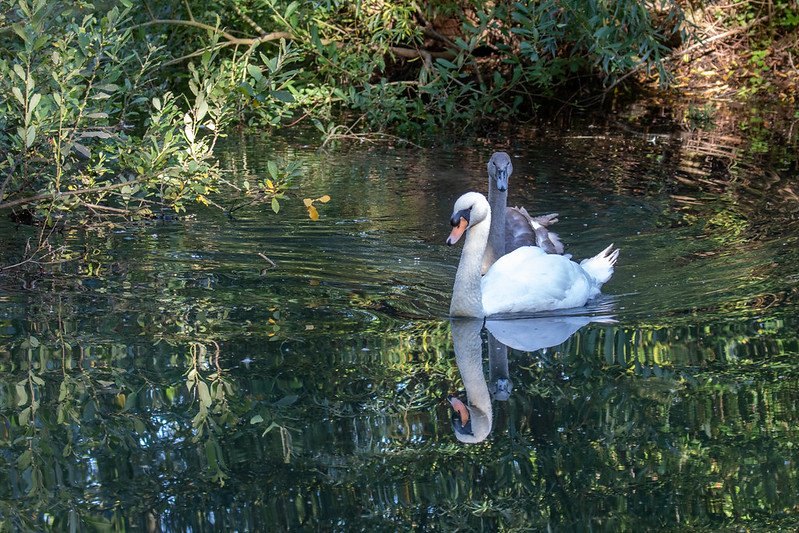 The camera overexposed the white bird
The camera overexposed the white birdIf you’re shooting up close and your camera sees nothing but white, it will often try to compensate by making the whole picture darker, leaving your swan looking a bit grey and grubby. If your camera settings are adjustable, try experimenting with them to retain all that lovely detail in the feathers.
Finally, that glorious sunshine we all love can actually be your enemy.
Bright, overhead sun creates ugly, harsh shadows that can spoil a photo. Some of the best pictures are taken when the sun isn't so strong, like earlier in the morning or later in the day during that lovely 'golden hour'.
Or, even better, on a gloomy day! An overcast sky or a bit of mist can help you take the most wonderfully atmospheric shots. The photo below was taken on a very misty morning, and I think it just oozes atmosphere.
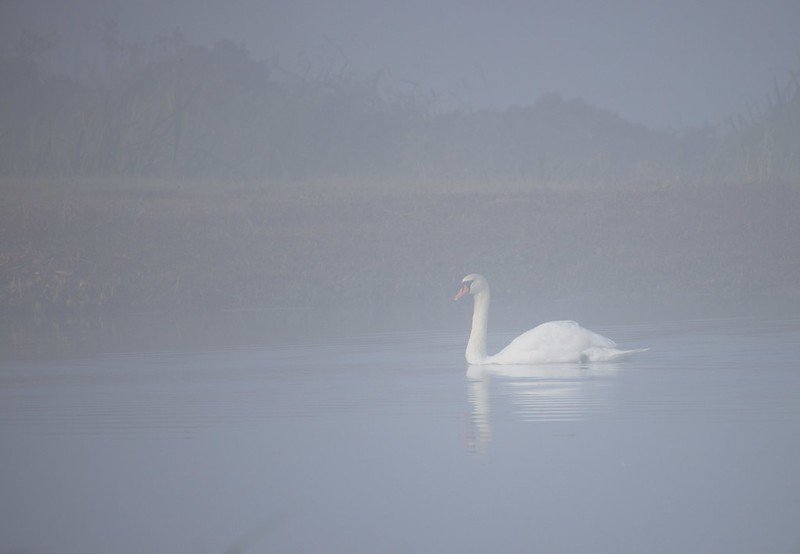 Shooting on overcast or misty mornings can create wonderfully atmospheric swan photos like this one.
Shooting on overcast or misty mornings can create wonderfully atmospheric swan photos like this one.And one last thought—it’s always worth making sure you’ve correctly identified what you’re looking at. Our familiar Mute Swan isn’t the only species of swan you might find on UK waters, as I mentioned earlier.
Comparing UK Swan Species
Our Mute Swan is the familiar, elegant resident we see all year round. But in the winter, if you're lucky, you might spot one of our two very special visitors who arrive from much colder parts of the world.
The first is the Whooper Swan. They’re a similar size to a Mute Swan, but you'll know them instantly by their posture. They hold their necks poker-straight, with none of the Mute’s graceful ‘S’ curve.
And their beak is completely different—a striking wedge of bright yellow on black. They’re also the noisy ones, often making a loud ‘whooping’ call, so you might even hear them before you see them.
They should all head back to Iceland for the summer, but I remember seeing an injured one once at Frampton Marsh in Lincolnshire. It spent the whole summer on its own, just patiently waiting for its friends to return in the autumn. A long, lonely wait.
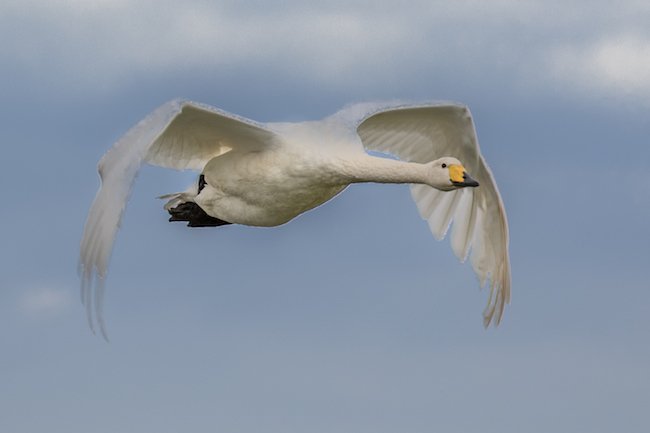 The Whooper Swan in flight – note the straight neck and bill shape.
The Whooper Swan in flight – note the straight neck and bill shape.The other winter visitor is the Bewick's Swan, which comes all the way from Arctic Russia.
They are noticeably smaller, but again, it’s all about the neck and beak. They also hold their necks straight, but the secret is to look closely at the yellow patch on the bill. On a Bewick's, it’s more of a rounded, oval shape, not the long, pointy wedge you see on the Whooper. It’s a subtle difference, but it’s still there.
Spotting a Bewick's is becoming a real privilege, though. Sadly, their numbers have dropped so significantly in recent years that they are now on the UK’s Red List of birds, which makes every single sighting feel that much more precious.
Black Swans
Now, there is one more swan you might just stumble across in your travels, and this one is a bit of a surprise.
The Black Swan isn't native to the UK, but a famous colony has made its home in the seaside town of Dawlish in Devon, where they’ve been living wild for over a hundred years. The town council even helps manage them.
And if you ever see their cygnets, you’ll be reminded straight away of the ugly duckling story. They are wonderfully scruffy, grey fluffballs, looking nothing at all like their magnificent parents with those incredible, striking red beaks.
I’ve been lucky enough to see all but the Bewick's in the wild now. Every single time feels like a real privilege. So if you get the chance to spend a bit of time with any of these graceful birds, please do. You won’t be disappointed.
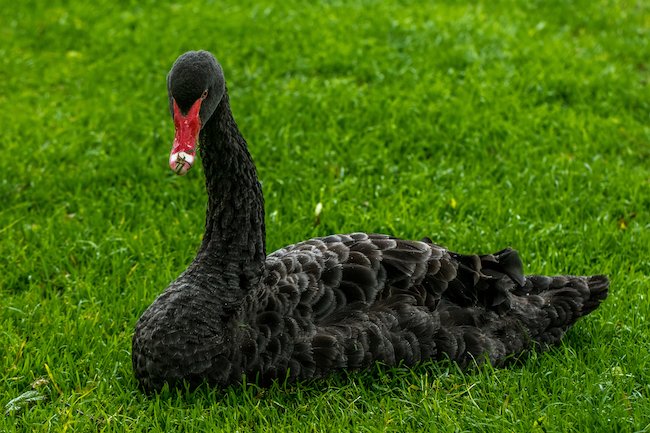 The non-native Black Swan, famous resident of Dawlish, Devon, is easily identified by its dark plumage and bright red bill.
The non-native Black Swan, famous resident of Dawlish, Devon, is easily identified by its dark plumage and bright red bill.Where To Go Next
Related Wildlife Guides
A Mute Swan Attack - A mute swan attack can be ferocious, as we discovered when two male mute swans began fighting in front of us!
The Great Crested Grebe - Follow the great crested grebe through a full breeding season—courtship displays, floating nests, fuzzy chicks, and stunning wildlife photography
Ducks in the UK - Ducks in the UK are more varied than you might think; discover where to find them and how to tell them apart on your next walk near water.
Related Photography Tips
Understanding the Histogram in Photography - Learn the vital role of a histogram in photography to achieve correct exposure, so you can adjust for underexposed or overexposed shots with confidence.
Related Walks & Locations
Rutland Water - An account of a day spent photographing the wildlife at this important reservoir and wildfowl reserve.
Grafham Water - Explore Grafham Water, a Site of Special Scientific Interest (SSSI) in Cambridgeshire, on a virtual stroll around the reservoir.

About the Author
For me, it’s never been just about bird names or camera settings, but the thrill of seeing a distant speck turn into a hunting kestrel.
After years of learning how to notice and photograph those moments, my camera has become the tool - and this site the field notebook - where I share what I’ve discovered.
If you’re ready to look a little closer, you’ll find the trips, lessons, and small wins that can help you see and photograph the wildlife right on your doorstep.
Step Behind the Wild Lens
If you’ve enjoyed your time here, you can also follow along by email.
I send the Wild Lens newsletter occasionally. It’s where I share:
- Fresh field notes and recent encounters
- The stories behind favourite photos
- Practical tips that don’t always make it onto the site
You’ll get new UK wildlife guides, photo tips, and ideas for your next walk, straight to your inbox.

